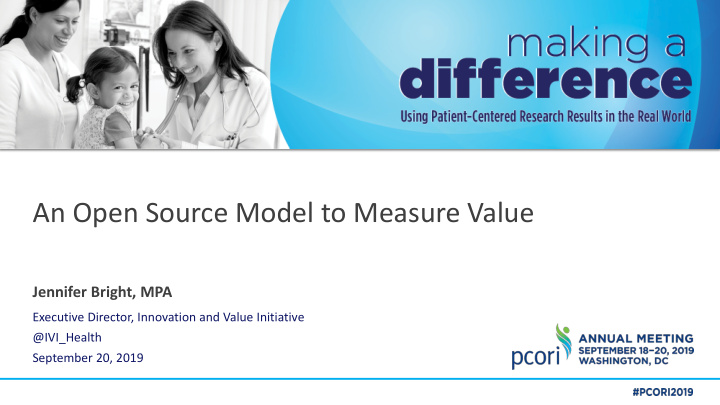



An Open Source Model to Measure Value Jennifer Bright, MPA Executive Director, Innovation and Value Initiative @IVI_Health September 20, 2019
Jennifer Bright, MPA Disclosures Rela latio ionship ip Company ny(ies es) Speakers Bureau Advisory Committee National Health Council Board Membership Mental Health America Consultancy Cancer Support Community, FasterCures Review Panel Honorarium National Health Council Ownership Interests Momentum Health Strategies, LLC 2
Status Quo Models for Value Assessment • What is missing? • Real-world data on patient quality of life and value perspectives • Other cost factors important to payers • Multiple methods for analysis • Transparency about how the model works 3
Employers and Value • Employers understand value in a broader context of total cost of care, but need reliable tools and information that can help them make immediate decisions • Employers are not really in a position to do value assessments themselves; outsourced analysis • Are third parties delivering comprehensive insight on value? • Employers may not engage directly in value assessment, but they also stand to lose a lot if it is not done well 4
Making a Difference… • The Innovation and Value Initiative (IVI) is an independent 501c3 research organization created to raise the level of discussion around value in healthcare by bringing together all participants in the system – academics, patients, patient advocates, payers, life sciences companies, providers, delivery systems, and other stakeholders – to find common ground in the approach for measuring value. • MISSION: Advance the science and improve the practice of value assessment in healthcare. • GOAL: Build a platform that facilitates robust and rigorous patient- centered value assessment of health technologies to the needs and interests of individual decision-makers. 5
IVI envisions a healthcare system that rewards value based on its core principles. 6
Key Elements to a Better Discussion About Value • Patient involvement and perspective first • Transparent environment for development and solutions • Methods focus – finding new ways to interpret information to give insight and drive better discussion and dialogue • Iterative methods improvement • Develop and test ways to incorporate real-world data 7
The Open Source Value Platform • IVI developed the Open-Source Value Platform (OSVP) as a new approach to assessing value. • The OSVP is a transparent and open- source system for estimating the value of medical technologies in a way that centers on the patient, allows for a broad range of perspectives, incorporates the latest available evidence, and considers the full range of scientifically defensible approaches. 8
9
Darius N. Lakdawalla, Jalpa A. Doshi, Louis P. Garrison, Charles E. Phelps, Anirban Basu, Patricia M. Danzon, Defining Elements of Value in Health Care—A Health Economics Approach: An ISPOR Special Task Force Report [3], Value in Health, Volume 21, Issue 2, 2018, Pages 131-139. Accessed at https://doi.org/10.1016/j.jval.2017.12.007. 10
A Look Into the Future • Value assessment models that extend beyond Rx to medical devices, technologies, and other therapeutic modalities • Value assessment models that expand beyond clinical data to include real-world patient perspectives and considerations, including risk tolerance, out of pocket expenses, desire for independent living, and lived experience • Value assessment models that consider and quantify multiple perspectives (e.g. patients and their caregivers) 11
Essential Questions • Does your internal analysis focus solely on clinical evidence (i.e., randomized control trial data) or does it also incorporate real-world data sources? Which sources are used to understand patient experience in treatment and patient subgroup response to treatments? • Does your value assessment evaluate treatment factors that are important to patients and their caregivers and may have an impact on indirect costs? How? • Our employees and their families represent a diverse population both demographically and with respect to health status and needs. What are your steps and approaches to ensure that your recommendations to us for benefit design and management reflects that diversity? 12
The Bottom Line • Value needs to address factors important to both patient and employer perspectives • Employers (and their employees) need to know that the health coverage they are paying for is delivering the highest value of care: • Optimized for time and patient characteristics and circumstances • Optimized for clinical and cost impacts • Value assessment should be able to: • Facilitate an analysis relevant to an employer’s specific population they cover (versus a generalized population) • Offer flexible analysis over time that accommodates new evidence, new methods and new decision questions • Incorporate multiple methods for comparison and compatibility to localized needs 13
Thank You! Jennifer Bright, MPA Executive Director, Innovation and Value Initiative @IVI_Health September 20, 2019 14
Recommend
More recommend